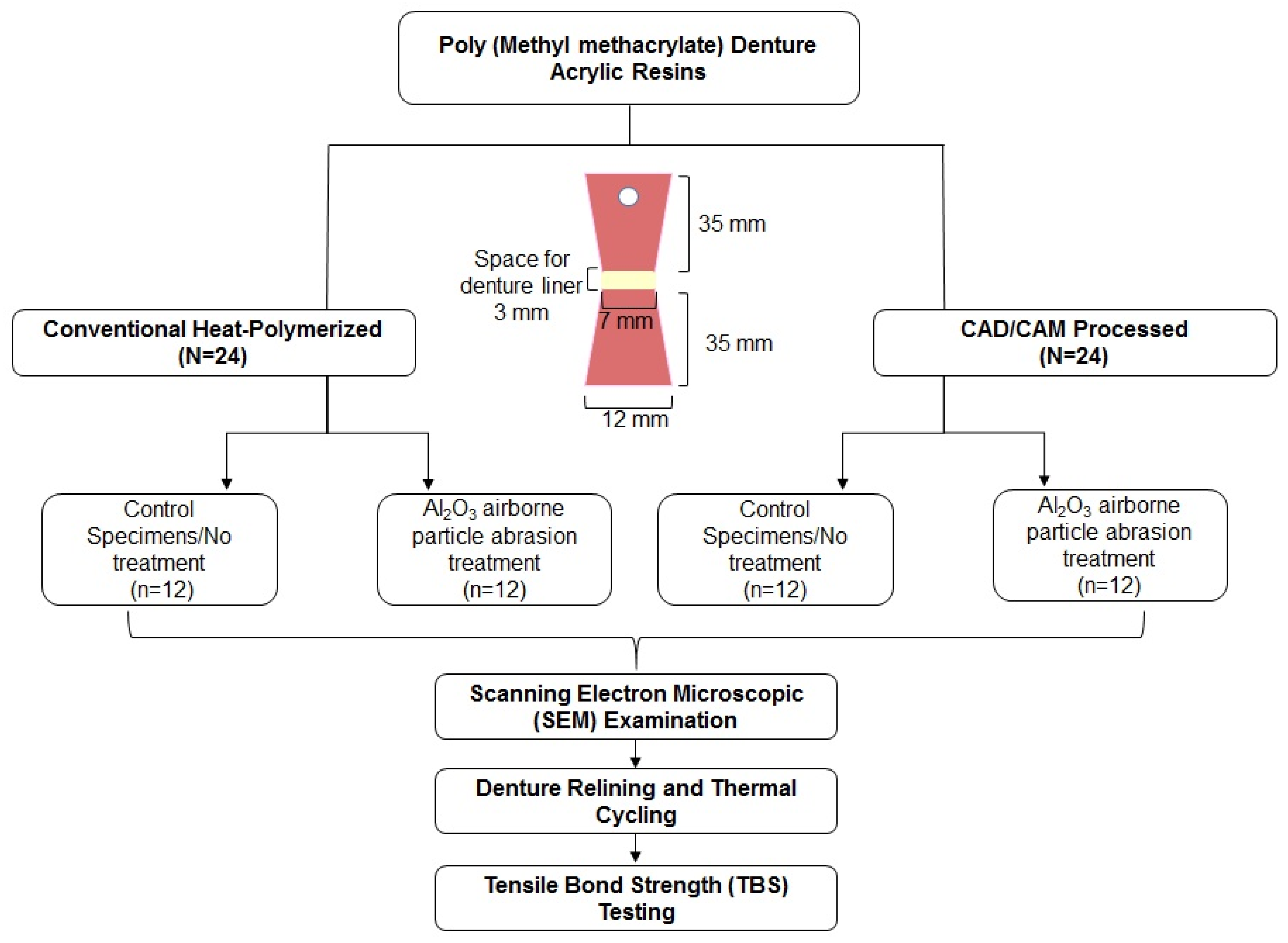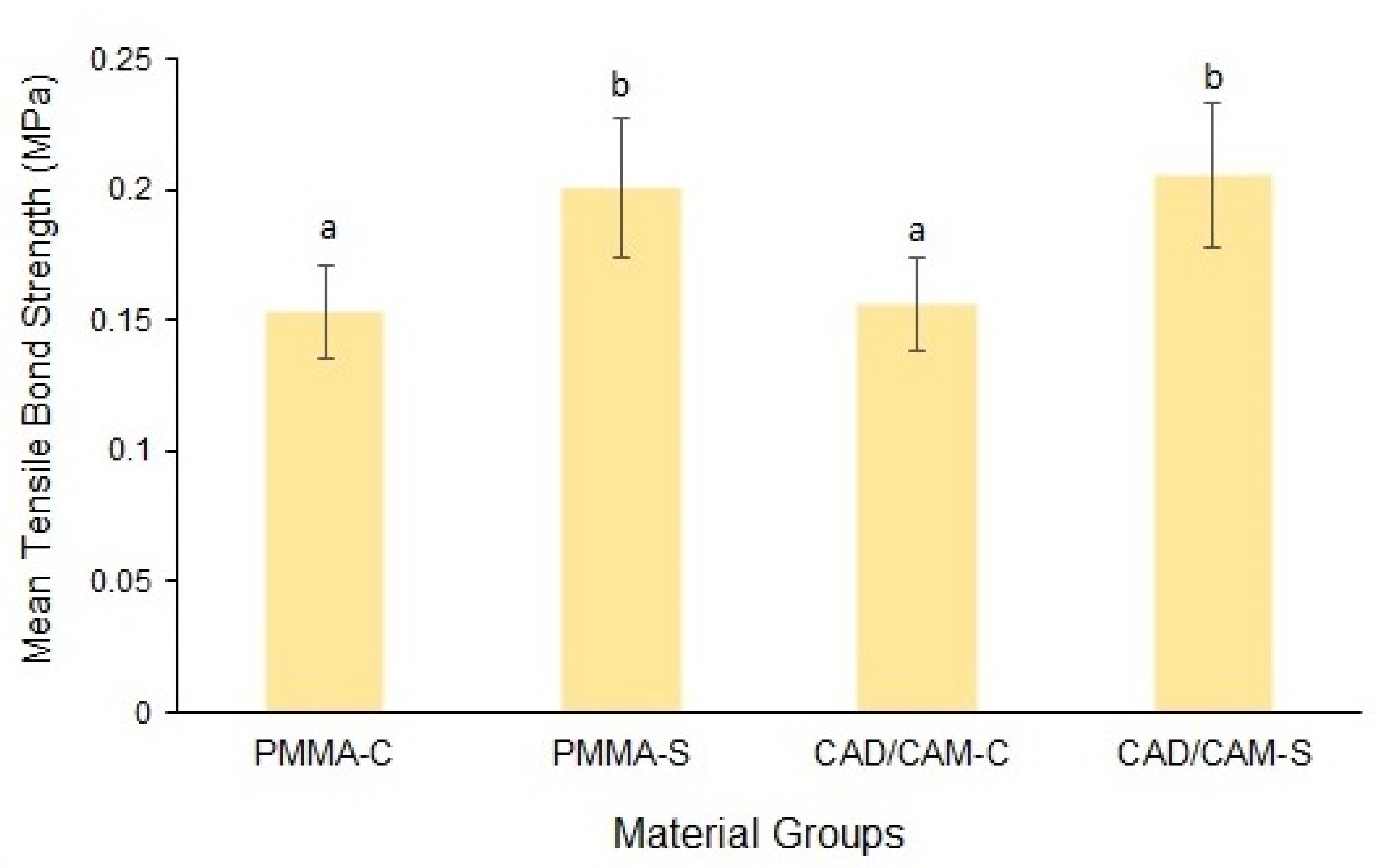Soft Denture Liner Adhesion to Conventional and CAD/CAM Processed Poly(Methyl Methacrylate) Acrylic Denture Resins-An In-Vitro Study
Abstract
:1. Introduction
2. Materials and Methods
2.1. Specimen Preparation
2.2. Surface Treatment of Specimens and Scanning Electron Microscopic (SEM) Evaluation
2.3. Denture Relining and Thermal Cycling Procedure
2.4. Tensile Bond Strength (TBS) Testing
2.5. Statistical Analysis
3. Results
3.1. Scanning Electron Microscopic (SEM) Observation
3.2. Tensile Bond Strength (TBS) Test Outcome
3.3. Failure Mode Analysis
4. Discussion
5. Conclusions
Author Contributions
Funding
Institutional Review Board Statement
Informed Consent Statement
Data Availability Statement
Conflicts of Interest
References
- Boucher, C.O. Complete denture prosthodontics—The state of the art. J. Prosthet. Dent. 2004, 92, 309–315. [Google Scholar] [CrossRef]
- Mahboub, F.; Salehsaber, F.; Parnia, F.; Gharekhani, V.; Kananizadeh, Y.; Taghizadeh, M. Effect of denture cleansing agents on tensile and shear bond strengths of soft liners to acrylic denture base. J. Dent. Res. Dent. Clin. Dent. Prospect. 2017, 11, 183–188. [Google Scholar] [CrossRef] [Green Version]
- Choi, J.E.; Ng, T.E.; Leong, C.K.; Kim, H.; Li, P.; Waddell, J.N. Adhesive Evaluation of Three Types of Resilient Denture Liners Bonded to Heat-Polymerized, Autopolymerized, or Cad-Cam Acrylic Resin Denture Bases. J. Prosthet. Dent. 2018, 120, 699–705. [Google Scholar] [CrossRef]
- Nowakowska-Toporowska, A.; Raszewski, Z.; Wieckiewicz, W. Color change of soft silicone relining materials after storage in artificial saliva. J. Prosthet. Dent. 2015, 115, 377–380. [Google Scholar] [CrossRef]
- Kutlu, I.U.; Yanikoğlu, N.D.; Kul, E.; Duymuş, Z.Y.; Sağsöz, N.P. Effect of sealer coating and storage methods on the surface roughness of soft liners. J. Prosthet. Dent. 2015, 115, 371–376. [Google Scholar] [CrossRef] [PubMed]
- Bail, M.; Jorge, J.; Urban, V.M.; Campanha, N.H. Surface Roughness of Acrylic and Silicone-Based Soft Liners: In Vivo Study in a Rat Model. J. Prosthodont. 2013, 23, 146–151. [Google Scholar] [CrossRef] [PubMed]
- Kreve, S.; Dos Reis, A.C. Denture Liners: A Systematic Review Relative to Adhesion and Mechanical Properties. Sci. World J. 2019, 2019, 1–11. [Google Scholar] [CrossRef] [PubMed] [Green Version]
- Atsu, S.; Keskin, Y. Effect of silica coating and silane surface treatment on the bond strength of soft denture liner to denture base material. J. Appl. Oral Sci. 2013, 21, 300–306. [Google Scholar] [CrossRef]
- Valentini, F.; Luz, M.S.; Boscato, N.; Pereira-Cenci, T. Biofilm formation on denture liners in a randomised controlled in situ trial. J. Dent. 2013, 41, 420–427. [Google Scholar] [CrossRef] [Green Version]
- Elias, C.; Henriques, F.Q. Effect of thermocycling on the tensile and shear bond strengths of three soft liners to a denture base resin. J. Appl. Oral Sci. 2007, 15, 18–23. [Google Scholar] [CrossRef] [Green Version]
- Emmer, T.J.; Emmer, T.J.; Vaidynathan, J.; Vaidynathan, T.K. Bond strength of permanent soft denture liners bonded to the denture base. J. Prosthet. Dent. 1995, 74, 595–601. [Google Scholar] [CrossRef]
- Al-Athel, M.; Jagger, R.; Jagger, D. Effect of ageing on the bond strength of a permanent denture soft lining material. J. Oral Rehabil. 2002, 29. [Google Scholar] [CrossRef]
- Pinto, J.R.R.; Mesquita, M.F.; Nóbilo, M.A.D.A.; Henriques, G.E.P. Evaluation of varying amounts of thermal cycling on bond strength and permanent deformation of two resilient denture liners. J. Prosthet. Dent. 2004, 92, 288–293. [Google Scholar] [CrossRef]
- Jacobsen, N.L.; Mitchell, D.L.; Johnson, D.L.; Holt, R.A. Lased and sandblasted denture base surface preparations affecting resilient liner bonding. J. Prosthet. Dent. 1997, 78, 153–158. [Google Scholar] [CrossRef]
- Minami, H.; Suzuki, S.; Ohashi, H.; Kurashige, H.; Tanaka, T. Effect of surface treatment on the bonding of an autopolymerizing soft denture liner to a denture base resin. Int. J. Prosthodont. 2004, 17, 297–301. [Google Scholar] [PubMed]
- Nakhaei, M.; Dashti, H.; Ahrari, F.; Vasigh, S.; Mushtaq, S.; Shetty, R.M. Effect of Different Surface Treatments and Thermocycling on Bond Strength of a Silicone-based Denture Liner to a Denture Base Resin. J. Contemp. Dent. Pract. 2016, 17, 154–159. [Google Scholar]
- Takahashi, Y.; Chai, J. Assessment of shear bond strength between three denture reline materials and a denture base acrylic resin. Int. J. Prosthodont. 2002, 14, 531–535. [Google Scholar]
- Usumez, A.; Inan, O.; Aykent, F. Bond strength of a silicone lining material to alumina-abraded and lased denture resin. J. Biomed. Mater. Res. 2004, 71B, 196–200. [Google Scholar] [CrossRef]
- Al-Fouzan, A.F.; Al-Mejrad, L.A.; Albarrag, A.M. Adherence of Candida to Complete Denture Surfaces In Vitro: A Comparison of Conventional and Cad/Cam Complete Dentures. J. Adv. Prosthodont. 2017, 9, 402–408. [Google Scholar] [CrossRef] [PubMed] [Green Version]
- Arslan, M.; Murat, S.; Alp, G.; Zaimoglu, A. Evaluation of flexural strength and surface properties of prepolymerized CAD/CAM PMMA-based polymers used for digital 3D complete dentures. Int. J. Comput. Dent. 2018, 21, 31–40. [Google Scholar]
- Atalay, S.; Çakmak, G.; Fonseca, M.; Schimmel, M.; Yilmaz, B. Effect of Thermocycling on the Surface Properties of Cad-Cam Denture Base Materials after Different Surface Treatments. J. Mech. Behav. Biomed. Mater. 2021, 121, 104646. [Google Scholar] [CrossRef]
- Gruber, S.; Kamnoedboon, P.; Özcan, M.; Srinivasan, M. Cad/Cam Complete Denture Resins: An In Vitro Evaluation of Color Stability. J. Prosthodont. 2020, 31, 13246. [Google Scholar] [CrossRef] [PubMed]
- Goodacre, B.J.; Goodacre, C.J.; Baba, N.Z.; Kattadiyil, M.T. Comparison of denture base adaptation between CAD-CAM and conventional fabrication techniques. J. Prosthet. Dent. 2016, 116, 249–256. [Google Scholar] [CrossRef]
- Wimmer, T.; Gallus, K.; Eichberger, M.; Stawarczyk, B. Complete denture fabrication supported by CAD/CAM. J. Prosthet. Dent. 2016, 115, 541–546. [Google Scholar] [CrossRef] [PubMed]
- Botega, D.M.; Sanchez, J.L.L.; Mesquita, M.F.; Henriques, G.E.P.; Consani, R.L.X. Effects of Thermocycling on the Tensile Bond Strength of Three Permanent Soft Denture Liners. J. Prosthodont. 2008, 17, 550–554. [Google Scholar] [CrossRef]
- Demir, H.; Soygun, K.; Bolayir, G.; Dogan, A.; Keskin, S.; Dogan, O.M. Effects of Different Denture Cleansers on the Tensile Bond Strength of Denture Liners. J. Adhes. 2009, 85, 941–952. [Google Scholar] [CrossRef]
- Kawano, F.; Dootz, E.R.; Koran, I.I.I.A.; Craig, R.G. Comparison of Bond Strength of Six Soft Denture Liners to Denture Base Resin. J. Prosthet. Dent. 1992, 68, 368–371. [Google Scholar] [CrossRef]
- Kim, J.H.; Choe, H.C.; Son, M.K. Evaluation of adhesion of reline resins to the thermoplastic denture base resin for non-metal clasp denture. Dent. Mater. J. 2014, 33, 32–38. [Google Scholar] [CrossRef] [Green Version]
- Muddugangadhar, B.C.; Mawani, D.P.; Das, A.; Mukhopadhyay, A. Bond strength of soft liners to denture base resins and the influence of different surface treatments and thermocycling: A systematic review. J. Prosthet. Dent. 2020, 123, 800–806. [Google Scholar] [CrossRef]
- Akin, H.; Tugut, F.; Guney, U.; Kirmali, O.; Akar, T. Tensile bond strength of silicone-based soft denture liner to two chemically different denture base resins after various surface treatments. Lasers Med. Sci. 2012, 28, 119–123. [Google Scholar] [CrossRef]
- Chladek, G.; Żmudzki, J.; Kasperski, J. Long-Term Soft Denture Lining Materials. Materials 2014, 7, 5816–5842. [Google Scholar] [CrossRef] [PubMed] [Green Version]
- Al-Athel, M.S.; Jagger, R.G. Effect of test method on the bond strength of a silicone resilient denture lining material. J. Prosthet. Dent. 1996, 76, 535–540. [Google Scholar] [CrossRef]
- Cavalcanti, Y.W.; Bertolini, M.M.; Cury, A.A.D.B.; Da Silva, W.J. The effect of poly(methyl methacrylate) surface treatments on the adhesion of silicone-based resilient denture liners. J. Prosthet. Dent. 2014, 112, 1539–1544. [Google Scholar] [CrossRef] [PubMed]
- Mutluay, M.M.; Ruyter, I.E. Evaluation of bond strength of soft relining materials to denture base polymers. Dent. Mater. 2007, 23, 1373–1381. [Google Scholar] [CrossRef]
- Craig, R.G.; Gibbons, P. Properties of resilient denture liners. J. Am. Dent. Assoc. 1961, 63, 382–390. [Google Scholar] [CrossRef]
- Storer, R. Resilient Denture Base Materials. Part 1. Introduction and Laboratory Evaluation. Brit. Dent. J. 1962, 113, 195–203. [Google Scholar]
- Akin, H.; Tugut, F.; Mutaf, B.; Akin, G.; Ozdemir, A.K. Effect of different surface treatments on tensile bond strength of silicone-based soft denture liner. Lasers Med. Sci. 2010, 26, 783–788. [Google Scholar] [CrossRef] [PubMed]
- Gundogdu, M.; Duymus, Z.Y.; Alkurt, M. Effect of surface treatments on the bond strength of soft denture lining materials to an acrylic resin denture base. J. Prosthet. Dent. 2014, 112, 964–971. [Google Scholar] [CrossRef]
- Kulkarni, R.S.; Parkhedkar, R. The effect of denture base surface pretreatments on bond strengths of two long term resilient liners. J. Adv. Prosthodont. 2011, 3, 16–19. [Google Scholar] [CrossRef]
- Hakan, A.K.; Tugut, F.; Mutaf, B.; Guney, U.; Ozdemir, A. Effect of Sandblasting with Different Size of Aluminum Oxide Particles on Tensile Bond Strength of Resilient Liner to Denture Base. Cumhuriyet. Dent. J. 2011, 14, 5–11. [Google Scholar]
- Tugut, F.; Coskun, M.E.; Dogan, D.O.; Kirmali, O.; Akin, H. Tensile Bond Strength between Soft Liners and Two Chemically Different Denture Base Materials: Effect of Thermocycling. J. Prosthodont. 2015, 25, 319–323. [Google Scholar] [CrossRef] [PubMed]
- McCabe, J.F.; Carrick, T.E.; Kamohara, H. Adhesive bond strength and compliance for denture soft lining materials. Biomaterials 2002, 23, 1347–1352. [Google Scholar] [CrossRef]




| Groups (n = 12) | Adhesive Failure | Cohesive Failure | Mixed Failure |
|---|---|---|---|
| PMMA-C | 3 | 0 | 9 |
| PMMA-S | 4 | 0 | 8 |
| CAD/CAM-C | 2 | 0 | 10 |
| CAD/CAM-S | 3 | 1 | 8 |
| % distribution | 25% | 2% | 73% |
Publisher’s Note: MDPI stays neutral with regard to jurisdictional claims in published maps and institutional affiliations. |
© 2021 by the authors. Licensee MDPI, Basel, Switzerland. This article is an open access article distributed under the terms and conditions of the Creative Commons Attribution (CC BY) license (https://creativecommons.org/licenses/by/4.0/).
Share and Cite
Al Taweel, S.M.; Al-Otaibi, H.N.; Labban, N.; AlFouzan, A.; Shehri, H.A. Soft Denture Liner Adhesion to Conventional and CAD/CAM Processed Poly(Methyl Methacrylate) Acrylic Denture Resins-An In-Vitro Study. Materials 2021, 14, 6614. https://doi.org/10.3390/ma14216614
Al Taweel SM, Al-Otaibi HN, Labban N, AlFouzan A, Shehri HA. Soft Denture Liner Adhesion to Conventional and CAD/CAM Processed Poly(Methyl Methacrylate) Acrylic Denture Resins-An In-Vitro Study. Materials. 2021; 14(21):6614. https://doi.org/10.3390/ma14216614
Chicago/Turabian StyleAl Taweel, Sara Mohammad, Hanan Nejer Al-Otaibi, Nawaf Labban, Afnan AlFouzan, and Huda Al Shehri. 2021. "Soft Denture Liner Adhesion to Conventional and CAD/CAM Processed Poly(Methyl Methacrylate) Acrylic Denture Resins-An In-Vitro Study" Materials 14, no. 21: 6614. https://doi.org/10.3390/ma14216614






